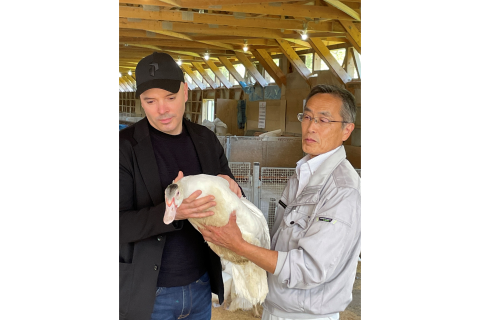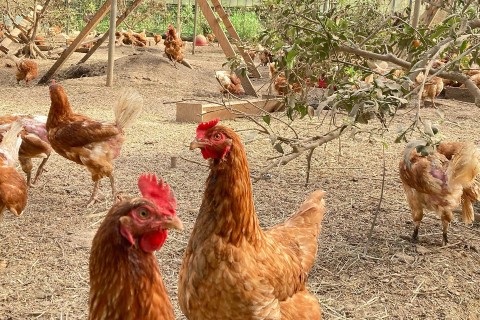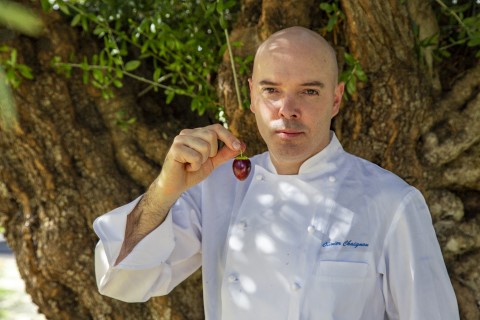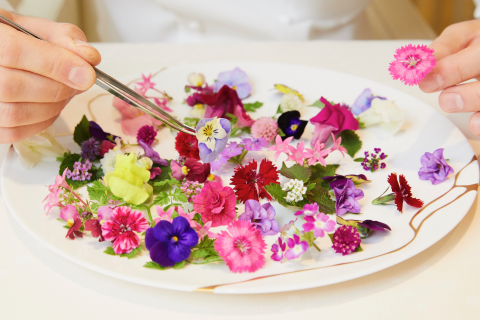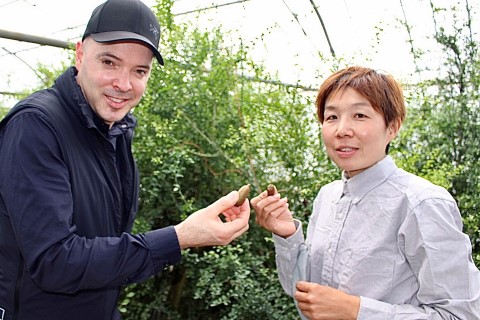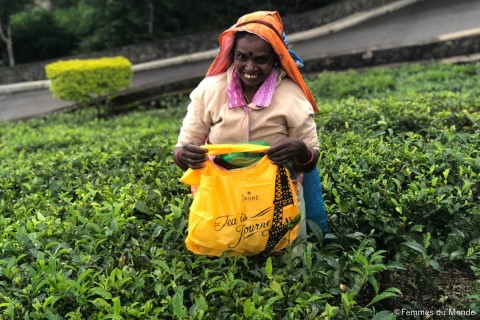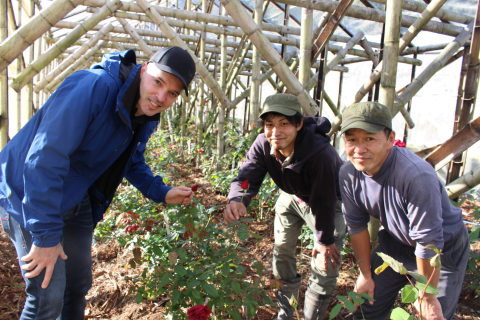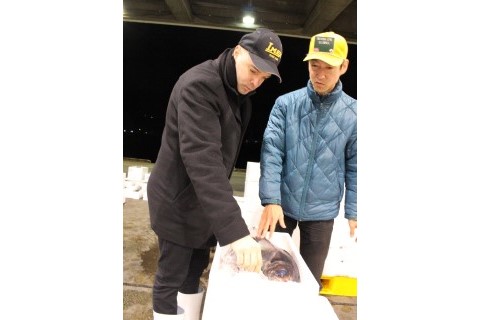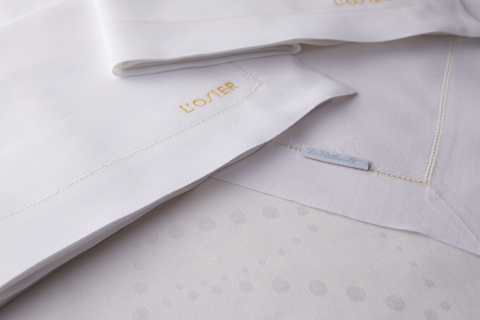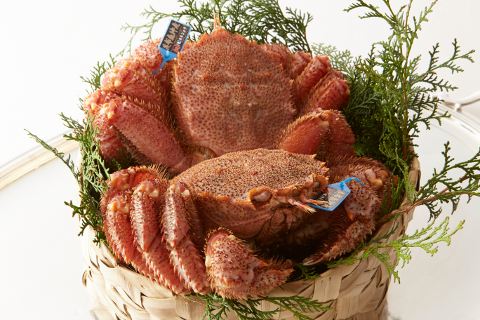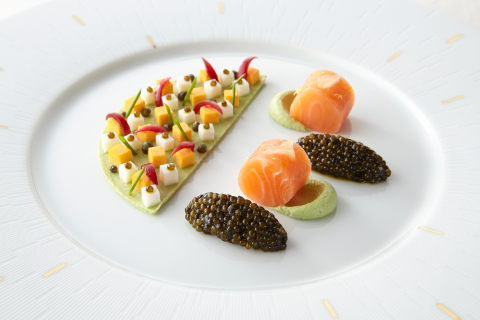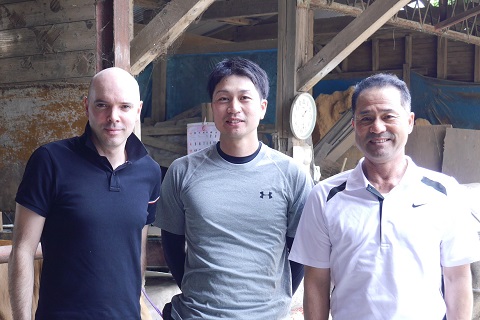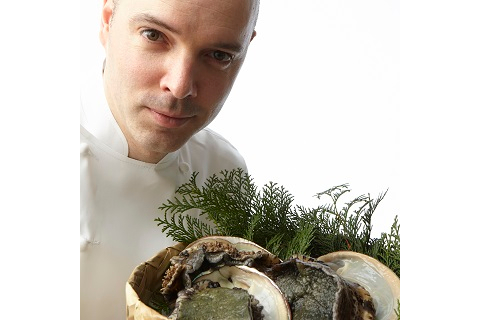【The blessed Gin no Kamo of Shingo】Towards the end of May of this year, Chef Chaignon visited the small rural village of Shingo up in Aomori Prefect...MORE
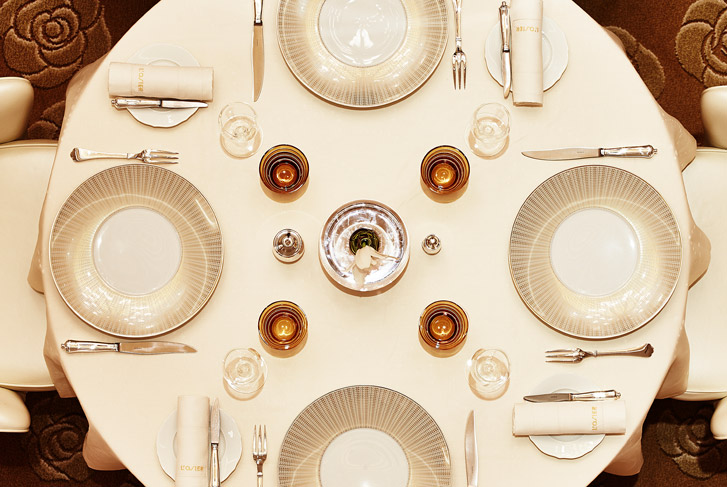
【L'OSIER Egg Project】The "Sustainable Egg Project" began with the "microbiome agriculture method"*¹ promoted by Chef Olivier Chaignon. This project ...MORE
【L’OSIER Overde Extra Virgin Olive Oil ~ Microbiome Agriculture and Microbiome Gastronomy】In late October, Chef Chaignon visited the Kingdom of Over...MORE
【Edible flowers of L’OSIER】The production site that Chef Chaignon visited this time was an edible flower farm in Matsuura City, Nagasaki Prefecture....MORE
【What Makes Finger Lime (Citron Caviar) So Special】One of the ingredients Olivier Chaignon selects for use in his dishes is finger lime.These finger...MORE
【L'OSIER Original Tea by Olivier Chaignon/Tea for Two Project: SDGs and Tea】Olivier Chaignon presents L’OSIER original tea, created with the concept...MORE
【L'OSIER's sustainable gastronomy】L'OSIER believes that without protecting our beautiful environment, it will be impossible to obtain beautiful ingr...MORE
【FROM OCEAN TO PLATE—L’OSIER’s approach to sustainable fishing】One of Olivier Chaignon’s specialties is an a la carte norimaki-style dish featuring ...MORE
【D. Porthault table linen, gracefully matching the space】From amongst the numerous tales studding the tableware of L’OSIER, following on from our Pu...MORE
【From Hand to Hand and Heart to Heart: Cutlery Communicating the Spirit of L’OSIER】Puiforcat cutlery constitutes an essential part of L’OSIER’s spir...MORE
【A Stunning Presence: Encountering “Hokkaido Kegani” in the Sea of Okhotsk 】 Among the dishes sought after by our customers, from early spring to e...MORE
【Hakkaisan salmon】It was love at first sight. Since the spring of 2017, Hakkaisan salmon has enthralled executive chef Olivier Chaignon. Despite its...MORE
【Kumamoto Aka-ushi Beef】Matsusaka, Omi, and Kobe are the three top Japanese brands of beef which have driven the upsurge in premium Wagyu since the ...MORE
【It inevitably inspires our respect for nature】Abalone slice cooked in butter is one of the dishes that have captured the hearts of many patrons as ...MORE
Towards the end of May of this year, Chef Chaignon visited the small rural village of Shingo up in Aomori Prefecture in the north of Japan to talk with our resident duck farmer.
Perhaps best known for being the rumoured real home and resting place of one Jesus Christ, this relatively remote hillside hamlet, with its modest population of around 2,000, is also home to some particularly fresh and tasty spring water. This, coupled with the area’s abundant natural scenery, makes for the ideal setting in which to raise our “Gin no Kamo” ducks.
Here, Mr Hatanaka told Chef Chaignon about how microbiome farming methods have greatly impacted the quality of production.
“Through microbiome farming, our ducks generally seem much healthier and happier. We’ve mixed the active “lactic acid bacteria” ingredient in with their feed and their growth rate has increased dramatically. Their natural immunity also seems to have strengthened, and they clearly like the new feed, too, as they seem really eager to get at it!”
Hatanaka, who has been raising ducks for 35 years, also pointed out that there was little to no smell in the air as the ducks happily and energetically roamed around in their clean, generously spacious anatine environment.
The feathery fellows here are testament to the fact that microbiome farming, as well as being far more environmentally friendly overall, allows livestock to develop immunity through the organic powers of lactic acid bacteria and their natural metabolites, thus eliminating the need for health-impacting antibiotics.
Essentially identical to the high-quality Barbary duck breed of Northern France, the Gin no Kamo has already become a staple of L'Osier cuisine. Our duck dishes serve as but one of many examples of Chef Chaignon’s staunch dedication to sustainable, health-driven culinary practices, and his insistence on using only the finest ingredients in creating each and every L’Osier menu item – which he does with great consideration and compassion.
The "Sustainable Egg Project" began with the "microbiome agriculture method"*¹ promoted by Chef Olivier Chaignon. This project has finally borne fruit, with eggs produced using the microbiome farming method now available as an item on the menu at L’OSIER.
It is an egg from Momiji, a purely domestic chicken from a farm in Imari City, Saga Prefecture (more than 95% of egg-laying hens in Japan originate from foreign countries). You may think the yolk is light in color, but the color of the yolk depends on what kind of feed the hens are eating.
This farm does not use compound feed from feed manufacturers but works with local farmers and fishermen offering marine-derived feed ingredients to produce a naturally derived feed that is unique to Imari. The feed is mixed with lactic acid bacteria and its metabolites*², which enables "microbiome agriculture". The cage mortality rate for chickens eating this feed is a whopping 0%. Even in the midst of the raging bird flu epidemic, the chickens on the farm fed the new feed have recorded a mortality rate of zero, showing the positive effects of the new feed.
In addition, the chickens grow well and stress-free in a spacious environment with one bird per square meter, which is close to the natural environment.
Chef Chaignon speaks enthusiastically while holding a fresh egg delivered from Saga Prefecture:
“This egg was created in cooperation with the farmers who were interested in microbiome farming. It is one of the ingredients that make possible the 'microbiome gastronomy' that I advocate. I am delighted to have had the opportunity to meet with the producers and work with them to create together food that not only tastes good, but also has an impact on health. I look forward to continuing to work with the producers to gain their support for these efforts."
*¹
The microbiome farming method uses a product of lactobacilli, carefully selected from among 200 species of Lactobacillus genus lactobacilli, and their metabolites. In the case of vegetables and fruits, this product is spread on the soil to create a unique microbiome ecosystem, which enables pest-free organic farming without the use of chemical fertilizers or pesticides. Foods produced by "microbiome agriculture" are rich in vitamins, minerals, and other nutrients. By cooking with the maximum amount of food produced by this farming method, a "microbiome gastronomy" is created that enables "health and longevity".
*²
In the Sustainable Egg Project, a blend of lactic acid bacteria is mixed with chicken feed to improve the intestinal environment of chickens.
In late October, Chef Chaignon visited the Kingdom of Overde, located in the southern coastal Spanish city of Alicante, to harvest olives.
True to the area’s reputation of having 345 days of sun in a year, not a single cloud was seen during the entire visit. The expansive, 30-hectare Kingdom of Overde has several thousand years of history and still shows clear traces of ancient Roman terracing.
The Kingdom of Overde is home to the oldest species of olive tree in the world, the Royal Cazorla, of which there are 888 planted in a heart-shaped formation.
The limestone soil was formerly a seabed and is extremely dry, seemingly far from fertile at first sight, but nevertheless allowing the 100- to 1,000-year-old trees to grow large olives.
Late October is also the harvesting season for the native pomegranates hanging heavily from branches next to the olive grove. During the day, the sun’s rays are so strong they almost burn the rinds of the pomegranates. The scarcity of rain and the strong sunlight make for harsh climatic conditions which actually work to strengthen the microbial life in the soil and trees, according to the microbiologist who talked to us about microbiome farming.
“Here, there is a unique ecosystem of microorganisms formed over several thousand years. The trees planted around the olive trees, including fig, grapefruit, and pomegranate, as well as herbs and vegetables, are all closely interconnected through the soil in this ecosystem. Because these trees benefit from the microbiota* and their metabolites, we are able to harvest fruits and vegetables which are rich in vitamins, minerals, and lactobacilli.”
The olives were harvested on the day of the full moon, when they had ripened to the pinnacle of taste, aroma and nutritional value. Each hand-picked olive was cold pressed using traditional methods and bottled unfiltered to preserve their flavor. The olives go from harvest to oil in about 3 hours. The Kingdom’s name of Overde derives from “oro verde,” Spanish for green gold, which is reflected in the greenish-gold resplendence of their Extra Virgin olive oil, successfully produced again this year.
Packed with the power of nature, L’OSIER Overde Extra Virgin Olive Oil is slightly spicy, moderately piquant and intensely fruity. The fruitiness is reputedly due to the influence of the fruit trees planted around the olive grove…
“When I touched the olive tree called Zeus, which is 2,300 years old, I felt the indescribable power of nature on my whole body,” says Chef Chaignon. “All during the harvesting work, immersed in serene quietude and surrounded by trees, I was given energy from the good earth. Next to the oldest trees there was a beautiful spring, where we took a drink of water and washed our hands and face after the olive harvesting. This spring also seemed to be influenced by the microbiome – even though we had spent the whole day walking around the Kingdom of Overde in the hot sun, the water seemed to soothe our fatigue away completely.”
The microbiota of the Kingdom of Overde has a unique ecosystem which enables plants to flourish even in the harsh natural conditions. The product inspired by the microbiological ecosystem of the Kingdom of Overde is a blend of lactobacilli selected from 200 strains. Sprinkling this product on the soil causes a unique microbial ecosystem to emerge, enabling the farmer to practice organic agriculture that is impervious to pests even in the absence of chemical fertilizers or pesticides.
The foods produced by microbiome agriculture are rich in vitamins, minerals, and other nutrients. Microbiome Gastronomy maximizes the use of microbiome-farmed produce to promote health and longevity.
“I want to promote microbiome agriculture in Japan, too,” Chef Chaignon says. “For that to happen, we first need to teach farmers about microbiome agriculture. Cooking with microbiome-farmed produce is the Microbiome Gastronomy that I advocate.”
Inspired by the olive trees, Chef Chaignon speaks of his aspirations. “Going forward, I believe that cuisine should not only be tasty but also have an impact on our health. Microbiome Gastronomy is what can provide foods which are enjoyable while contributing to health and longevity. I am committing myself to the practice of Microbiome Gastronomy.”
* Microbial communities in the ecosystem
The production site that Chef Chaignon visited this time was an edible flower farm in Matsuura City, Nagasaki Prefecture. In a village with a panoramic view overlooking the ocean, there is a greenhouse for edible flowers. The Maeda family has been growing horticultural plants since the previous generation, but after becoming fascinated with edible flowers, they have been growing various varieties of colorful flowers in the greenhouse so that they can ship edible flowers all year round.
Chef Chaignon could relate himself to Mr. Maeda’s passionate words with a twinkle in his eyes, saying, “There are flowers that I didn't even know they were edible until now. I really enjoy the challenge of growing edible flowers, which I had never grown before.”
As Chef Chaignon tasted the edible flowers one after another with great interest, Mr. Maeda taught him the names and characteristics of the flowers one after another. The chef was deeply impressed by edible flowers, which differ not only in color and shape, but also in taste and aroma, each of which is slightly different from one another.
Chef Chaignon said, "I am deeply moved to think that the flowers Mr. Maeda carefully nurtured in this environment blessed with nature are now blooming on my plates.”
His favorite flowers to order for L’OSIER are small-sized edible flowers in yellow and purple. They give color without distracting from the ingredients on the plate, adding subtle aromas and flavors. The chef arranges the cooked ingredients on the plate as if painting a picture, and then adds the edible flowers. Finally, a sauce, the lifeblood of French cuisine, is added to complete the dish.
The dainty flowers contrasting with the dynamic floral arrangements decorating the dining room at L’OSIER, which change with the seasons each month, can also be enjoyed on Chef Chaignon's plate.
One of the ingredients Olivier Chaignon selects for use in his dishes is finger lime.
These finger-shaped citrus fruits have small pearls that burst with juice. Because of the similarity of their textures, in French they are called "citron caviar," and in English they are also known as "caviar limes."
One of L'OSIER's dishes made with finger lime is scallop topped with sturgeon caviar and finger lime pearls (OSSETRA CAVIAR, LETTUCE BALL STUFFED WITH MAYQUEEN, SLICED SCALLOP FROM SANRIKU, FINGER LIME FROM MIYAZAKI, SAFFRON FLAVORED CHAMPAGNE SAUCE). The crisp pearls add a splash of color and freshness to the dish.
There are numerous varieties of finger limes, which grow in the dry tropical rainforests along the coast of Australia, and they come in many beautiful colors, such as green, yellow, red, and pink.
Australia only began exporting them in roughly the year 2000, making the finger lime a relatively new ingredient.
Only a very small amount of finger lime is grown in Japan, so it is also a very rare ingredient. Chaignon recently visited a finger lime farm in Miyazaki City, Miyazaki Prefecture. The reason that L’OSIER can use finger lime year-round is that the two chief growers at the farm carefully cultivate it in a greenhouse. Finger limes were once assumed to be easily damaged by the cold, but the growers found that it handles the cold relatively well, and they can grow it even in winter without using a large amount of energy to keep the greenhouse warm. They also found that, since greenhouse cultivation also prevents pest concerns, they could grow the finger limes organically, without the use of pesticides.
"Not only do different varieties of finger limes have different colors of pulp, but they also have a tremendous range of flavors and scents," explained Jun Maruyama, one of the growers, as he presented Chaignon with a new variety of finger lime to sample. "Just smelling them fills you with joy."
The other grower, Hiroko Nagatomo, began growing several varieties of finger lime five years ago, culminating in the Mia Rose and Red Ruby varieties, which are excellent fits for the local soil. These varieties are supplied directly to L’OSIER. "When I found out that Chef Chaignon was making dishes that further brought out the delicious flavors of the finger limes I grow, it filled me with joy and really encouraged me," said Nagatomo.
Chaignon learned that for the growers of finger limes, knowing that there was a restaurant that steadily used these high-end ingredients encouraged them to continue to produce finger limes. This impressed on Chaignon, again, the importance of communication between those who produce ingredients and those who use them.
Finger limes, which glitter like caviar, are certain to continue to inspire Chaignon to create new dishes.
Olivier Chaignon presents L’OSIER original tea, created with the concept of "travel," that combines the finest Sri Lankan tea leaves, grown organically without the use of pesticides, and precious spices and fruits from around the world.
Executive chef of L’OSIER Olivier Chaignon embarks on a program to support women tea-pickers in Sri Lanka, one of the world’s foremost tea producers, in partnership with Femmes du Monde, a charitable NPO that has been working for the social and economic empowerment of women in Sri Lanka for over 20 years.
L’OSIER Original Tea promotes the “Tea for Two Project”, in which we share with the tea-producing women of Sri Lanka, the happiness of spending special time drinking tea with someone. From growing the tea, to picking, production, tasting, quality control, packaging, and transportation, women are involved in more than 90% of the work relating to tea. The Femme du Monde foundation strives to transform the tea production process into a sustainable framework which empowers women, giving working women education and skills to generate joy and passion for their work. One cup of L’OSIER original tea helps support the happy livelihoods of Sri Lankan tea-producing women and their families.
Among the original flavored tea ingredients is turmeric from the Kingdom of Bhutan—a country known for its proactive efforts to conserve its largely untouched natural environment—which L’OSIER discovered as part of its sustainable food ingredient sourcing drive.
L’OSIER original teas reflect Chaignon’s flair for achieving exquisite and delicate combinations of diverse food ingredients and flavors.
He hopes its original teas will help bring happiness and hope to greater numbers of women tea workers.
There are 4 kinds of L’OSIER original tea:
1. Jardin Secret ("Secret Garden")
This tea is made with premium black tea leaves hand-picked at a hidden plantation in the village of Dimbula, located in central Sri Lanka.
The tea leaves are then fermented in oak barrels painstakingly made using traditional methods by a barrel maker in the Champagne region of France. This imparts a special, deep flavor to the tea.
These oak barrels from Champagne have received "Enterprise du Patromoine Vivant (Living Heritage Company, or EPV)" labels, issued by the French government to companies which use superb traditional techniques. A patent has also been issued for the process by which the oak barrels are used to create delicate nuances in the black tea.
The richness of the tea leaves will fill your mouth with an almost floral aroma and a smoky, refined taste. The rich, structured flavor is one of fruitiness, with just the right notes of vanilla, raisin, and saussurea. (This flavor comes from the tea leaves themselves. No spices or fruit have been added.)
Ingredient:
Sri Lankan black tea leaves (grown on plantations supported by Femmes du Monde).
2. Rêve du Bhoutan ("Dreams of Bhutan")
This special blend is made with turmeric grown on farms operated by the Bhutanese royal family, vanilla from Madagascar, natural orange essence from Spain's Valencia region, and natural essence of pears grown in the “King’s Vegetable Garden” in Versailles, France.
The spicy yet delicate turmeric combines with smooth, gentle vanilla and a sweet, fruity finish.
Ingredients:
Sri Lankan black tea leaves (grown on plantations supported by Femmes du Monde), Bhutan turmeric (grown on farms owned by Her Majesty Queen Grandmother of Bhutan), natural essence of Valencia oranges from Spain, and natural essence of pears from France (grown in the “King’s Vegetable Garden” in Versailles).
3. Douceur d'Alicante ("Sweet Alicante")
Grapefruit hits first, followed by a burst of cherry that fills your mouth. The aroma and taste of this fruity blend features a distinctive, lingering cardamom. The flavors of natural essences, extracted from organically grown, pesticide-free fruit, evoke the tranquil scenery of Alicante, Spain.
Ingredients:
Sri Lankan black tea leaves (grown on plantations supported by Femmes du Monde), cardamom (from the Kandy region of central Sri Lanka), natural cherry essence (from Spain's Alicante region), and natural grapefruit essence (from Spain's Valencia region).
4. Touche Millénaire ("Millennium Touch")
This special blend is made with the natural essence of apples and roses grown in the Potager du roi (“King’s Vegetable Garden”)in Versailles, France, camellia leaves from Ofunato City, Iwate Prefecture* and olive leaves from 1,000-year-old olive trees in the "Kingdom of Overde" orchard in Spain's Alicante region.
The bold aroma and taste of roses are matched with delicate nuances of apple and balanced by the flavor of camellia and olive leaves.
Ingredients:
Sri Lankan black tea leaves (grown on plantations supported by Femmes du Monde), natural essence of apples from France (grown in the “King’s Vegetable Garden” in Versailles), natural essence and petals of roses (grown in the “King’s Vegetable Garden” in Versailles), camellia leaves (from Ofunato City, Iwate Prefecture), and olive leaves from Spain (from 1,000-year-old olive trees in Alicante).
* The tea is blended with camellias leaves from Ofunato City, Iwate Prefecture, where Shiseido planted camellias trees as a part of its post-earthquake reconstruction assistance program.
L'OSIER believes that without protecting our beautiful environment, it will be impossible to obtain beautiful ingredients or pass on our beautiful culinary culture to future generations. This is what is behind our dedication to sustainable initiatives related to food.
Our dishes are made with ingredients such as fish caught through sustainable pole and line fishing, chickens and eggs from eco-friendly poultry farms, and organically-grown, pesticide-free vegetables.
In early November, Chef Olivier Chaignon visited Kozagawa, a town nestled in a valley in southern Wakayama Prefecture. With a space half as large as Tokyo’s 23 wards, it has a population of just over 2,700. Roughly 96% of the town’s area is covered by forested mountain, and it has numerous clear streams. It is also home to a farm that attracts young growers from places such as Osaka and Kyoto. Here, they harness symbiosis between diverse microorganisms to develop their own soil, growing vegetables and edible roses using natural farming techniques, without the use of pesticides, chemical fertilizers, or animal fertilizers. This avoids the use of animal fertilizer because it could introduce the antibiotics given to animals and the agricultural chemicals used in animal feed into the farm’s fields, allowing them to get into its crops, to later be ingested by the people who eat them. When Chaignon visited, young staff members were making a greenhouse out of bamboo and reused construction materials.
Mr. Doi, one of the farm staff, says, “All we can do is grow food and send it out to the world. However, it has true meaning only when it is actually eaten.” Chaignon replied, “I choose the ingredients you take such care to produce, use them in my cuisine, and serve them for customers to L'OSIER. This completes the cycle.” Chaignon sees himself as a bridge, connecting producers to consumers. In this voyage of ingredient exploration, Chaignon felt the allure of Kozagawa, where young growers gather to protect the beauty of nature and produce beautiful foods. It supplies the roses used in L'OSIER’s desserts, whose fragrance fills your senses with every bite.
One of Olivier Chaignon’s specialties is an a la carte norimaki-style dish featuring grouper and longtooth grouper landed in Nagasaki Prefecture.
A new dish that came out in February this year, IMAGE OF SPRING’S “NORIMAKI” features grouper freshly landed that morning. The fish is rolled, topped with fish mousse, covered in thinly sliced truffles and steamed up.
Grouper and longtooth grouper are becoming increasingly rare even in Nagasaki. They have a fresh, firm feel and smooth texture, which Chaignon likes. These are special ingredients sourced directly from fish brokers throughout the year.
In February 2020, when there was just a slight hint of spring in the air, Chaignon made his first visit for the year to a producing district. The destination was the Nagasaki Fish Market in Kyodomari, Nagasaki-shi in Nagasaki Prefecture, where the restaurant’s grouper and longtooth grouper are purchased. Early every morning, Chaignon learns about the catch of the day via a phone call with his trusted brokers. The selected fish is then bought at auction and airlifted to L’OSIER. On the day of his visit, Chaignon was shown around the Nagasaki Fish Market for the first time by the brokers. Arriving at the market at 4:30 a.m., Chaignon noticed an atmosphere that was different from that of Tsukiji or Toyosu, markets he has been to many times. He was also impressed by the passion of the brokers, who are careful to select only the highest-quality fish.
For Chaignon, who wishes to engage in environmental issues, it is concerning that the annual catch is decreasing, even at Nagasaki Port, which consistently makes it into the top five sites for annual catch volume. Told by the brokers that “we don’t know if it’s just that there are fewer fishermen in Nagasaki now, or if there are fewer fishermen because there are fewer fish,” Chaignon says he “felt it was time I took action as a chef.”
“What I can do as a chef now is to choose fish caught by pole-and-line fishing rather than by bottom trawling,” he continues. “I am going to continue to think about what chefs can do to make sure we can always get good-tasting fish from beautiful fishing grounds with a protected ecosystem.”
From amongst the numerous tales studding the tableware of L’OSIER, following on from our Puiforcat cutlery, we would like to introduce the story of D. Porthault table linen.
The table linen is something that all the service staff of L’OSIER take great care of each and every day. As well as the three types of linen consisting of the under cloth and top cloth that are placed over the tables, and the napkins, did you know that the torchons carried by the service staff, the bar napkins, even the hand towels in the powder rooms and virtually every piece of linen used at the restaurant has been specially made to order by the famous French linen manufacturer D. Porthault?
D. Porthault is France’s premier manufacturer of linen, their products loved by the British royal family, generations of French presidents, many other royal families and celebrities. Ever since its establishment in the year 1920, its delicate sewing and smooth sensation on the skin is said to have won it the cherished use of figures including Marilyn Monroe, Catherine Deneuve and Jacqueline Kennedy.
The material is all woven at the company’s studio in the town of Cambrai in northern France, where the cutting, sewing and embroidery as well as eventual manufacture are all managed on an integrated basis. With the company’s dedicated designers, while the simple yet tasteful designs unique to D. Porthault are handed down, they also create many high-quality order-made items that make the best use of the skills of French craftsmen.
At L’OSIER, where we have insisted upon the linen of D. Porthault since the year 1986, the table linen was completely changed during the 2013 autumn renewal. Selected from a number of design sketches proposed by D. Porthault’s dedicated designers, was the “rising Champagne bubbles” motif created by Pierre Yves Rochon, who produced the interior designs for L’OSIER.
To express the delicate-bubble texture, the Jacquard weave technique was chosen for its three-dimensional motif created through the irregular warp and weft. Carefully woven one by one, the napkins are finished with a special stitching called “jours echelle,” and inlaid in their finest details with the most sophisticated techniques that D. Porthault has built up over many long years.
Monsieur Crouton, who has for a long time been in charge of the linen for L’Osier at D. Porthault says: “ For us, L’OSIER is not just another client. We provide linen for many famous three-star restaurants in Paris, but as the one customer for which we are able to be involved in the entire process from the selection of the material to sewing and embroidery, the process of making an original work from zero, L’OSIER is more like a partner that helps to express our view of the world.”
The table linen that Monsieur Crouton extols as “one of the products of which we are most proud.” We hope that you will enjoy experiencing its beautiful textures for yourself at L’OSIER.
Puiforcat cutlery constitutes an essential part of L’OSIER’s spirit of hospitality. When it relocated to Ginza’s Namiki-dori in 1999, L’OSIER switched to procuring silverware only from Puiforcat, the long-established French silversmith brand. L’OSIER selected a total of 900 pieces of cutlery, as well as platters, sugar pots and other tableware, invariably of an artistic quality and rarity which today would make them museum pieces out of the reach of most. L’OSIER’s treasured Puiforcat collection, of a size unrivalled by any restaurant in Japan, has to this day been carefully and lovingly maintained, and is served to customers daily along with the cuisine of executive chef Olivier Chaignon.
Both L’OSIER and Puiforcat boast rich traditions and have demonstrated their commitment to craftsmanship on many occasions. L’OSIER floor manager Yasuhiko Uchibori, who has for many years supervised the wait staff of the restaurant, says the long-time relationship with Puiforcat has very special significance for L’OSIER:
“Puiforcat silverware embodies the essence of L’OSIER’s service, which is respect for customers. Carefully serving carefully prepared food may be matter of course, but a French restaurant doggedly maintaining the style of serving each dish from a silver platter at the table is becoming a rarity, even here in Tokyo. At the very root of this time-honored serving style, which involves staff members shuttling between the kitchen and tables carrying heavy silver platters, is our ‘everything for the customer’ ethos, unchanged since the restaurant first opened.”
At L’OSIER, new staff members are thoroughly initiated into the art of looking after silverware. Twice a day, after the lunch and dinner service, each piece is carefully polished with a soft cloth; this is an essential daily routine. According to Uchibori, by polishing each piece so that it is in perfect condition at all times, employees learn firsthand the weight and value of the silverware item, which in turn positively affects their outlook and attitude toward service.
“L’OSIER’s Puiforcat silverware communicates the time and dedication that have gone into keeping the pieces pristine for nearly 20 years, and our pride in delivering Japan’s top-class cuisine and service.”
----------------------------------
Puiforcat Brand Overview : Established in 1820 by Emile Puiforcat in the Marais district of Paris, known for its many orfèvres (gold and silver workshops), Puiforcat is a venerated French silverware maison widely reputed to represent the pinnacle of contemporary silverware. Its cutlery, painstakingly made by artisans from highest-grade silver, is used at dinner parties at the Élysée Palace, the official residence of the President of France. An Hermès group company since 1993, the company to this day continues to uphold its craftsmanship and tradition.
Among the dishes sought after by our customers, from early spring to early summer, we receive requests in particular upon booking for à la carte dishes which use “Hokkaido Kegani” (horsehair crab). For example, the “Hokkaido Kegani Crab Crustacea Custard”, available from around the end of March to May, is such a dish. It has plump textured and sweet crab meat mounted upon a crustacea custard with asparagus ice cream contained within. Between the sourness of the crustacean cream filled turnip, the crunchy texture of the green asparagus, the contrast between the different temperatures of the custard and ice cream; the stunning presence of the flavor of the horsehair crab is exceptional, says executive chef Olivier Chaignon.
In his trip Chaignon visited his preferred port for horsehair crab from where he has had crabs sent alive since he was first fascinated by its rich flavor – Saruru, in Okoppe-cho, Monbetsu-gun, on the northern island of Hokkaido. The seas around Saruru are abundant in plankton and it is a port which boasts plentiful seafood from the Sea of Okhotsk. Chaignon visited at the end of March, a peak period for fishing the rare high-grade horsehair crab “umiake kegani” just when the drift ice has left. This is also when time has passed since molting (i.e., the body is hard and the meat is firmly packed in) and the highest rated rank “katagani” can be caught.
Chaignon, suddenly showing an expression of excitement as a good catch of horsehair crab is unloaded from a ship that has just finished its early morning fishing, straight away tries a freshly caught and just boiled crab. “The meat is really closely packed into the shell, isn’t it? As I thought, the way the meat is packed in and the delicacy of the meat have quite an impact. There is little moisture and the meat is very tight and so the sweetness is also concentrated. I think the appeal of Monbetsu horsehair crab is also in the beauty of the ever more vivid red it becomes when boiled.”
L’OSIER’s speciality horsehair crab: delivered to our kitchens still alive from the fishing port of Saruru in Okoppe-cho. So as not to lose the extremely delicate texture and sweetness, Chaignon boils it slowly together with white wine and vegetables to express without sparing the splendor of the supple meat and the plump, well-rounded flavor. Our à la carte dishes, including Crab Crustacea Custard, that use various techniques to present the charm of Hokkaido Kegani horsehair crab can be enjoyed together with seasonal ingredients up until August.
It was love at first sight. Since the spring of 2017, Hakkaisan salmon has enthralled executive chef Olivier Chaignon. Despite its name, the fish is actually a type of rainbow trout; however, as one might imagine, it is raised very differently from its more ordinary cousins. Fresh springwater from the sacred mountain Hakkaisan, renowned for its fine sake, is drawn to provide an environment which is infinitely close to untouched nature. Here, the Hakkaisan salmon are allowed to take their time, 50% longer than ordinary farmed trout, to grow to a large size.
Because they are raised exclusively on the mineral-rich springwater straight from Hakkaisan, and given plenty of time to grow at a low water temperature, Hakkaisan salmon are free from the distinctive odor of freshwater fish and have no excess fat. They also have no eggs or sperm, which means their meat contains the entirety of their goodness and flavor. “They are lower in fat compared to salmon,” says Chaignon, “and their fat is fresh and clean. The well toned flesh is smooth to the palate. I cannot say enough about the wonderful texture that overwhelms your mouth the instant you take one bite.” As his enthusiasm demonstrates, Hakkaisan salmon is an ingredient which captures the imagination of professionals skilled in French contemporary cuisine.
Inspired by the peerless flavor of Hakkaisan salmon is the popular a la carte offering, “Ossetra Caviar and Mi Cuit of Hakkaisan Salmon with Creamed Leeks and Condiments: “Zen” Buckwheat Blinis.”
To draw attention to its beautiful colors and exquisite texture, Hakkaisan salmon fillet is rolled tightly and cooked slowly at low temperature (mi cuit). After heating carefully, just to the point where the flesh dissolves smoothly in the mouth, the rolled fillet is cut and placed atop cream of leeks bursting with earthy flavor, and garnished with lemon fruit and zest. To the side, a generous portion of Ossetra caviar boasts a richness and flavor suggesting hazelnuts. The ultimate harmony with Hakkaisan salmon, which is free of excess oil, culminates instantaneously into a world of euphoric delight.
The condiment is also extraordinary, inspired by the Zen temples of Kyoto and modeled after Japanese stone gardens. The whites and yolks of eggs are likened to stones, adorned with capers, beet-tinted onions, and ciboulettes, each capped with a single bead of Ossetra caviar to embody the precisely ordered world of Zen. Wrap the Hakkaisan salmon, caviar, leeks, and condiment in the accompanying blinis and experience a new encounter with the aroma of buckwheat.
Flavor and richness, aroma, tartness, bitterness, and sweetness... The micro-level fusion in your mouth constructs a delectable pentagon of tastes for you to enjoy on your journey to the world of Hakkaisan Salmon, the wondrous food which captured the heart of Chaignon.
Matsusaka, Omi, and Kobe are the three top Japanese brands of beef which have driven the upsurge in premium Wagyu since the 1990s. In addition to these big-name brands, there are Yonezawa and Hida beef, as well as Shorthorn in Iwate and Hokkaido. In recent years, grass-fed New Zealand beef and the French Charolais beef are also gaining popularity on the wave of the red meat boom. Out of this multitude of choices, the brand which captured the heart of our Executive Chef, Olivier Chaignon, was Kumamoto Aka-ushi Beef, raised in the foothills of Mount Aso.
Roughly in the center of Kyushu, Mount Aso boasts one of the largest calderas in the world and a lush natural environment with clear water, pristine air, and green countryside in which the Kumamoto Aka-ushi is raised in stress-free surroundings. The appeal of this beef is its delicate marbling free of excess fat, and its exquisite tenderness underpinned by moderate firmness. The more it is chewed, the more sweetness and umami (taste) burst in your mouth. It has both the meaty aroma and rich flavor of beef and the full-bodied flavor of Wagyu.
Chef Chaignon, enraptured by the wonderful taste of Aka-ushi beef, made a personal visit to a father-son team of cattle farmers, Eiki and Yasutaka Saito, in Kikuchi City, Kumamoto, which is known for its fine cattle. The passion of the Saitos gave Chef Chaignon an even deeper appreciation for this superb food.
“The quality, texture, and especially the relatively minimal marbling. The Aka-ushi is my idea of the perfect beef for my cuisine. In Kumamoto, I had a wonderful meeting with the beef farmers. Their lives revolved around the Aka-ushi, and everything they did was made possible by their passion, enthusiasm, and love for the Aka-ushi. What left the strongest impression on me was how happy the animals looked, in their beautiful natural environment which is meticulously maintained every day.”
The stalls are cleaned and serviced on a 24-hour basis to keep the animals free from stress and discomfort. They are fed hay and rice straw to develop their cud-chewing function, then raised lovingly on a diet consisting mainly of local Kumamoto-grown grains. While demand for this beef grows every year thanks to the rise in health consciousness and popularity of red meat, the increase in production has fallen short of expectations in the aftermath of the earthquake.
Each time he takes this beef in hand in his kitchen, Chef Chaignon renews his commitment. “I think of the incredible passion of the people I met in Kumamoto. The renewed sense of inspiration in food that I felt. I will cherish each piece of this rare and precious food, and express its worth with love and respect in every dish I create.”
※The photo on the preceding page shows (from right to left): Cattle farmers Eiki & Yasutaka Saito (father & son), and Olivier Chaignon.
Abalone slice cooked in butter is one of the dishes that have captured the hearts of many patrons as a specialty cooked by Executive Chef Olivier Chaignon since 2013, when L’OSIER was renewed and opened. This dish becomes available as the appetizer for a course dinner only when “the very best Japanese black abalone” of the year is delivered. In response to inquiries from clients who cannot “wait to taste it again,” it is a highly popular item added to the a la carte menu.
The encounter between Olivier and the Japanese black abalone occurred at a grilled-dish restaurant he says he visited shortly after arriving in Japan. The abalone grilled on a hot iron plate in an instant impressed him with quite a different texture and taste from small abalones landed in small quantities in Bretagne, France. Its texture and taste caused a sensational impact on his senses like he had never experienced before.
The “black abalone of Japan’s Boshu district” that is highlighted at this time boasts of by far the best quality among all abalones gathered in Japan. It is a really rare ingredient, weighing 500-600 grams a piece, including the shell. It goes on sale in a limited market only between May 1 and September 15, when the Chikura area in the southern Boso region, renowned as home to the black abalone, opens the season of female professional divers collecting abalones. The piece as heavy as 500-600 grams, as mentioned, changes hands at an extraordinarily high price even in the local fishing village as something that requires as long as 10 years to grow up to that size. Once shipped out, the rare ingredient draws buyers scrambling for this treasure.
At this time of the year that suits its landing, the black abalone collects nutrients actively toward the egg-laying period in October. It absorbs minerals from kelp drifting in abundant quantities over the seabed and grows up into a high-quality thick body. Abalones generally slim down when heated. But the “black abalone of Japan’s Boshu district” stays plump even after being heated. It maintains adequate elasticity yet remains moist and soft, one of its defining features.
Here comes Olivier’s representative specialty: abalone slice cooked in butter flavored with shiso flower creamy wheat and seaweed, and a sea urchin broth sauce. It is one of the dishes that the chef wants his clients to enjoy at this time of the year, when this select ingredient finally comes by. To maximize the delicate taste of the “black abalone of Japan’s Boshu district,” it is steamed in a typical Japanese cooking method at the first stage by using horse radish and Japanese sake. It is subsequently mixed with jus de coquillages, or bodily fluids of shells, in the state of pochee. Thanks to the combination with jelly lichen in bulgur (parched/crushed wheat) risotto underneath, and the sea urchin broth sauce based on shell fluids, the dish is enhanced with the smell of the sea and Umami taste, as well as profound flavors and textures, all elements interacting and overlapping mutually inside the mouth. As a result, abundant and plump gifts of the sea unfold in an in-depth marriage with each bite.
Olivier Chaignon’s deep thoughts of the “black abalone of Japan’s Boshu district” are found in the following statement.
“The encounter itself with this ingredient makes me feel happy. It’s one of the ingredients that inevitably stimulate my respect for nature. I cook it with gratitude for the blessings of the sea from the moment I touch it in the kitchen to the moment I arrange it on the plate.”








